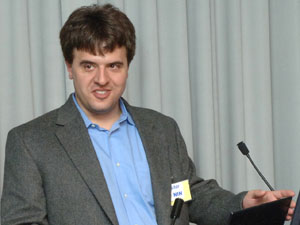| |
 |
|
|
|
|
| |
Dr. Karl Deisseroth is bringing his expertise in bioengineering to psychiatry. |
|
Using light to relieve suffering has a long history.
From ancient Egypt to Victorian London, unfiltered sunlight was regarded as a fundamental
cure for rashes, rheumatism and rickets.
As scientists discovered that light is not a simple
element—that it is both wave and particle, with a spectrum of bandwidths, some invisible to the human eye—they teased out its properties
and created more sophisticated treatments.
Phototherapy’s modern era begins with Niels Finsen, awarded the 1903 Nobel Prize in medicine
for the use of carbon-arc lamps to treat cutaneous tuberculosis—TB of the skin.
Today’s therapies include blue light to treat newborn
jaundice; lasers—intensely concentrated light—to repair vision; and light boxes to ease seasonal affective disorder, a form of depression.
In a recent visit to NIH, Stanford University’s Dr. Karl Deisseroth asked his audience to consider
this: What if we could treat psychiatric diseases like major depression with high-speed light pulses? And do that in a genetically targeted
way?
His talk, “Bringing Bioengineering to Psychiatry,”
was part of the NIMH Director’s Innovation
Speaker Series and drew an SRO crowd to the Neuroscience Center.
Deisseroth began with a basic statement of need. According to the World Health Organization,
major depression is the leading cause of disability, both in the U.S. and worldwide. In those age 5 and older, major depression is the leading cause of disabling disease.
“Psychiatry needs a quantitative approach,” he said. “Not to denigrate neurotransmitters, but simply talking about neurotransmitter levels doesn’t do justice to the brain as a high-speed processing and storage apparatus.”
Neurotransmitters are the brain’s biochemical
messengers; they affect mood and thinking. Some antidepressant drugs work by adjusting the levels of neurotransmitters.
Deisseroth’s lab combines technologies from optics, genetics and bioengineering to map neural-
circuit dynamics in psychiatric disease on a millisecond time scale. He holds a dual appointment
in bioengineering and psychiatry—“an unusual mix,” he says—and is the recipient of many honors, including the NIH Director’s
Pioneer Award.
Also a clinician in Stanford’s psychiatry department, Deisseroth sees patients weekly.
Brain cells important in both normal functioning and disease, he explained, are typically embedded in dense, complex tissue. This makes them hard to reach with conventional electrical stimulation methods. He and others have nonetheless used techniques such as transcranial magnetic stimulation or deep-brain stimulation
(DBS) to treat patients with refractory—unmanageable—depression.
He cited lessons learned from using DBS: “Subjects reported sudden calmness and lightness,” he said. This occurred in patients who had not responded to previous treatment.
With his expertise in bioengineering, he then developed methods that are “all optical—no electrodes.” Very simply, here’s how it works.
First, he adapted a naturally occurring protein from green algae, which contains a light-activated ion channel. Using this protein, he introduced a gene into mammalian
neural tissue. He then combined this technique with “high-speed optical switching”—pulses of light.
The result altered neural processing at the level of the synapse—the junction between nerve cells. Taking advantage of the noninvasive quality of light, he had found a way to “photostimulate” mammalian neurons.
“Just with the introduction of a single gene, without a chemical cofactor,” he said, “it was temporally precise and tunable on a millisecond scale.”
One of the things that impressed him most, he said, was that he found no toxicity:
no change in membrane resistance, resting potential or cell death.
Next, Deisseroth plans to investigate reward circuitry for addictive behaviors.
There is clinical need in other areas as well. In addition to targeting neurons, he said, his new technology could apply to “the excitable cells”: skeletal, cardiac, smooth muscle and the insulin-secreting beta cells.
“The common theme,” he said, “is the [current] lack of noninvasive, high-precision methods to control excitable cells for drug screening or therapeutics.” The faster you can screen drugs for side effects, the faster you can rule out the compounds that do harm. Thus the need for innovative work in “optogenetics.”
“You could greatly advance drug discovery,” he said.
He admits it will be a long time before this new paradigm will find clinical use in humans. “Maybe 5, 10 years,” he predicted. “But I think the tide will turn.” 